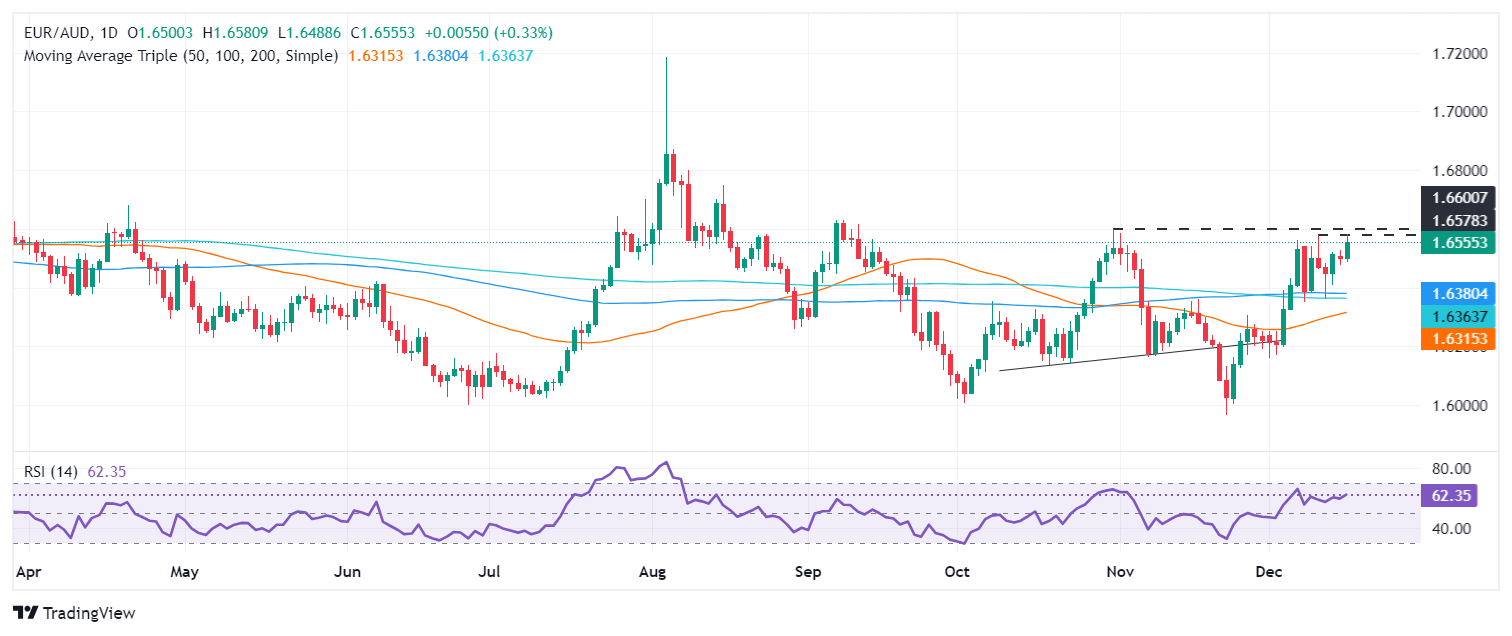- EUR/AUD climbs above the 1.6500 level amid cautious market mood.
- Technical analysis shows potential for further gains with the Relative Strength Index indicating bullish momentum.
- Resistance levels ahead at 1.6575 and 1.6600, with potential targets extending to 1.6759 if upward trajectory continues.
- Support found at 1.6500, with further downside protections at the 100-day and 200-day SMAs at 1.6375 and 1.6359, respectively.
The Euro extended its gains versus the Australian Dollar on Tuesday, amid a session characterized by a risk-off mood, sending high-beta currencies lower. At the time of writing, the EUR/AUD trades at 1.6557 up by 0.40%.
EUR/AUD Price Forecast: Technical outlook
The EUR/AUD has halted its uptrend and has consolidated at around 1.6500 for the last three trading days. Although momentum seems bullish, buyers must clear the October 31 peak of 1.6599 if they want to remain hopeful of extending their gains.
Momentum as depicted by the Relative Strength Index (RSI) favors further upside, with the RSI standing above the neutral level.
If EUR/AUD rises above the December 11 high of 1.6575, it would pave the way for further upside. A breach of the latter will expose 1.6600, followed by the August 15 daily high of 1.6759.
On the flip side, the EUR/AUD first support would be the 1.6500 mark. Once cleared, the next support would be the 100-day Simple Moving Average (SMA) at 1.6375, followed by the 200-day SMA at 1.6359.
EUR/AUD Price Chart – Daily
Euro FAQs
The Euro is the currency for the 19 European Union countries that belong to the Eurozone. It is the second most heavily traded currency in the world behind the US Dollar. In 2022, it accounted for 31% of all foreign exchange transactions, with an average daily turnover of over $2.2 trillion a day. EUR/USD is the most heavily traded currency pair in the world, accounting for an estimated 30% off all transactions, followed by EUR/JPY (4%), EUR/GBP (3%) and EUR/AUD (2%).
The European Central Bank (ECB) in Frankfurt, Germany, is the reserve bank for the Eurozone. The ECB sets interest rates and manages monetary policy. The ECB’s primary mandate is to maintain price stability, which means either controlling inflation or stimulating growth. Its primary tool is the raising or lowering of interest rates. Relatively high interest rates – or the expectation of higher rates – will usually benefit the Euro and vice versa. The ECB Governing Council makes monetary policy decisions at meetings held eight times a year. Decisions are made by heads of the Eurozone national banks and six permanent members, including the President of the ECB, Christine Lagarde.
Eurozone inflation data, measured by the Harmonized Index of Consumer Prices (HICP), is an important econometric for the Euro. If inflation rises more than expected, especially if above the ECB’s 2% target, it obliges the ECB to raise interest rates to bring it back under control. Relatively high interest rates compared to its counterparts will usually benefit the Euro, as it makes the region more attractive as a place for global investors to park their money.
Data releases gauge the health of the economy and can impact on the Euro. Indicators such as GDP, Manufacturing and Services PMIs, employment, and consumer sentiment surveys can all influence the direction of the single currency. A strong economy is good for the Euro. Not only does it attract more foreign investment but it may encourage the ECB to put up interest rates, which will directly strengthen the Euro. Otherwise, if economic data is weak, the Euro is likely to fall. Economic data for the four largest economies in the euro area (Germany, France, Italy and Spain) are especially significant, as they account for 75% of the Eurozone’s economy.
Another significant data release for the Euro is the Trade Balance. This indicator measures the difference between what a country earns from its exports and what it spends on imports over a given period. If a country produces highly sought after exports then its currency will gain in value purely from the extra demand created from foreign buyers seeking to purchase these goods. Therefore, a positive net Trade Balance strengthens a currency and vice versa for a negative balance.
Information on these pages contains forward-looking statements that involve risks and uncertainties. Markets and instruments profiled on this page are for informational purposes only and should not in any way come across as a recommendation to buy or sell in these assets. You should do your own thorough research before making any investment decisions. FXStreet does not in any way guarantee that this information is free from mistakes, errors, or material misstatements. It also does not guarantee that this information is of a timely nature. Investing in Open Markets involves a great deal of risk, including the loss of all or a portion of your investment, as well as emotional distress. All risks, losses and costs associated with investing, including total loss of principal, are your responsibility. The views and opinions expressed in this article are those of the authors and do not necessarily reflect the official policy or position of FXStreet nor its advertisers. The author will not be held responsible for information that is found at the end of links posted on this page.
If not otherwise explicitly mentioned in the body of the article, at the time of writing, the author has no position in any stock mentioned in this article and no business relationship with any company mentioned. The author has not received compensation for writing this article, other than from FXStreet.
FXStreet and the author do not provide personalized recommendations. The author makes no representations as to the accuracy, completeness, or suitability of this information. FXStreet and the author will not be liable for any errors, omissions or any losses, injuries or damages arising from this information and its display or use. Errors and omissions excepted.
The author and FXStreet are not registered investment advisors and nothing in this article is intended to be investment advice.
Recommended content
Editors’ Picks

EUR/USD corrects sharply toward 1.0950 ahead of US NFP, Powell
EUR/USD is extending its correction toward 1.0950 in the European session on Friday. The US Dollar has come up for air after the trade war and recession fears-led sell-off, weighing on the pair. Traders look to the US NFP report and Fed Chair Powell's speech for fresh directives.

GBP/USD remains heavy near 1.3000, US NFP data awaited
GBP/USD is battling 1.3000, under heavy selling pressure in European trading on Friday. Traders resort to profit-taking on their US Dollar short positiions, re-adjusting ahead of the critical US Nonfarm Payrolls data and Fed Chair Powell speech.

Gold price sticks to negative bias around $3,100; bears seem non-committed ahead of US NFP report
Gold price meets with a fresh supply on Friday, though the downside potential seems limited. Trump’s tariffs-inspired risk-off mood might continue to act as a tailwind for the precious metal. Fed rate cut bets weigh on the USD and also contribute to limiting losses for the XAU/USD pair.

Nonfarm Payrolls forecast: US jobs growth set to slow in March amid growing worries over US tariffs
Nonfarm Payrolls are forecast to rise by 135K in March, following a 151K gain reported in February. The United States Bureau of Labor Statistics will release the jobs data on Friday at 12:30 GMT. US labor data could impact the Fed’s interest rate path, potentially affecting the US Dollar's price action.

Trump’s “Liberation Day” tariffs on the way
United States (US) President Donald Trump’s self-styled “Liberation Day” has finally arrived. After four straight failures to kick off Donald Trump’s “day one” tariffs that were supposed to be implemented when President Trump assumed office 72 days ago, Trump’s team is slated to finally unveil a sweeping, lopsided package of “reciprocal” tariffs.

The Best brokers to trade EUR/USD
SPONSORED Discover the top brokers for trading EUR/USD in 2025. Our list features brokers with competitive spreads, fast execution, and powerful platforms. Whether you're a beginner or an expert, find the right partner to navigate the dynamic Forex market.




